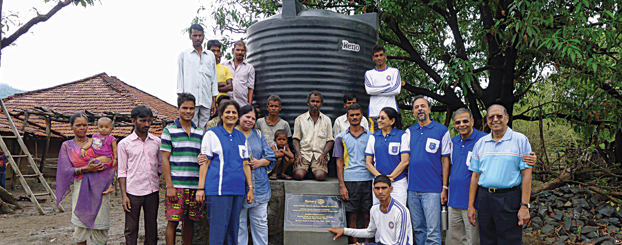

Just three hours from Mumbai, the commercial hub of India, lie a group of sleepy hamlets tucked away in the
interiors away from public gaze. This group of hamlets or ‘padas’ were the focus of Rotary Year 2013–2014, when the District Governor Lata Subraidu, along with the clubs of District 3140, decided to build 150 low cost houses, or ‘Rotary Kutirs’ for the poor in these hamlets. At that time, there was acute water shortage in the region and the villagers had to go without convenient access to water for 2–3 months of the year. Water collection was a huge challenge here and women and children had to walk for kilometres to the nearest river to fetch a few pots of water.
RC Mumbai Cuffe Parade, D 3140, along with Rotary Club of Rockville, District 7620, USA, applied for a Global Grant of $55,000 to TRF to build rain water harvesting structures in the villages of Ashta and Naroli. These villages have a population of about 700 inhabitants, and the livestock needed water too. The population here is mainly Adivasi. The grant was awarded in April 2014 and the work began in February 2015. OIKOS Agro Consultants, a company specialising in rural rain water harvesting, became a partner in the project.
Under this project, three check dams, three subsurface bunds, two new wells and six spring cordons were built and recharging of the existing bore well by roof rainwater collection was also executed to create a central distribution point in the village. The check dams are expected to build a reserve capacity of 7,000 cubic metres of water and help the villagers to cultivate a second crop, thus raising their incomes. Wells and spring cordons will provide drinking water throughout the year with the help of the subsurface bunds. Recharging the bore well will allow access to underground water and the central distribution of water will become the new nerve centre in the village. The project was handed over in June 2015 by President Mahendra Sundesha and IPP Rajul Parikh in the presence of the villagers and local panchayat officials.
Women benefit
Explaining the details and benefits of this project, Rajul says the women of these villages were the happiest in getting this additional source of water. By creating a spring cordon — effectively reinforcing a small natural pond or reservoir with concrete — “we’ve ensured that a cluster of 8–10 Rotary kutirs get water for an additional three months after the monsoon is over through one such spring cordon.”
An even bigger benefit, she adds, is that earlier the villagers were using the naturally sweet well water also for non-drinking purposes such as bathing, washing clothes, vessels and for their livestock. The result was wells drying up in April and leaving them high and dry … literally dry … in the summer months of May and June. “Now with additional water being available for their daily needs other than drinking, their well water lasts them even during the summer months.”
And with their time saved in fetching water from long distances, the women are able to give more time to their work both on the farms as well as home.
(With inputs from Rajul Parikh)





